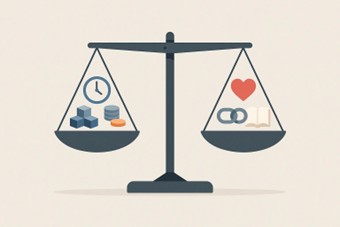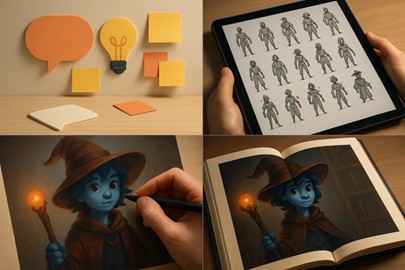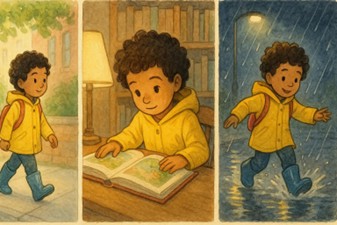In 2023, a self-published children’s book using entirely AI-generated illustrations sold over 20,000 copies, which sparked fascination and fury among illustrators.
That’s right. What used to take artists months of sketching, coloring, and revision is now sometimes done in a matter of minutes using artificial intelligence. AI vs human has been a hot topic for a while now, but in the past 3 years, the conversation has kicked into high gear in book illustration. In fact, over 70% of digital artists have reported using AI in their workflows to generate art at least once.
Whether you are a writer, illustrator, or curious reader, this debate is impossible to ignore. The rise of AI-generated art has stirred up a mix of awe, skepticism, and even fear in the creative world. Book illustration, a traditionally human-driven craft filled with emotion and nuance, is now on the front lines of that conversation.
But here’s the million-dollar question:
Can a machine really illustrate a story the way a human can feel it?
And when it comes to bringing books to life visually, who truly wins: AI or Human?
Let’s explore both sides of the coin.
The rise of AI in the arts has caused a mixture of enthusiasm and anxiety in the industry. Some see AI as a useful resource that can enhance our ways of creative expression, but there is a fear that it will replace or threaten traditional ways of working, and ultimately devalue humanity's craft, creativity, and originality in artistry.
So, rather than merely a creative tool, do we need to see AI as a true threat to an artist's role as a creator??
Increasing evidence suggests that AI is an enhancement to human creativity, rather than a replacement. A number of software companies, including Topaz Labs and On1, started incorporating the technology into their photo editing software. Topaz had both the capability and potential for creating Photoshop plugins. On1 quickly began to follow suit, and in a short period, both offered Photoshop plugins that were meant to assist users in enhancing the quality of images they took, using various photography editing tools that reduced digital images, sharpened, and enhanced more detail in images.
Adobe later entered the space with AI features, including neural filters in Photoshop. One popular example is the colorization of old black-and-white photos. The results are often striking, bringing new life to vintage images that once felt distant and monochrome. A previously static moment in time can now be seen with added vibrancy and realism.
In these cases, AI has been established as a helpful assistant rather than a replacement. The artistic vision remains preserved in the original photograph, captured through human effort. AI enhances what already exists.
While there is plenty of opportunity for collaboration, there are also legitimate fears of replacing human artists in book illustration. As companies look for cheaper solutions, more and more photo-realistic art is generated by AI for many purposes in illustration, including book covers, character illustrations, and more. Tons of jobs were traditionally filled by illustrators and designers, many of whom are concerned about the possibility of AI modifying their creative output, reducing demand for it, and subsequently, paying for human creatives' contributions as well.

This brings up larger things to consider about the economics of creativity.
When a computer can generate or manipulate art on command, usually at any scale, within seconds, and at minimal cost, how do we value the time, effort, and emotional labour of human art anymore?
Moreover, will audiences begin to accept algorithmically produced content as artistically sufficient, thereby shifting public perception of what constitutes “real” art?
Human art is deeply rooted in emotion, intention, and personal experience. Artists' work usually stems from their inspirations. They may use their life stories, cultural background, and feelings to design an illustration. Every brushstroke, color choice, or compositional decision is typically informed by a mix of intuition and learned technique. You can see the final result, having a distinctive touch of the artist, which you won’t see anywhere else.
If we try to find that element in AI art, you’ll probably fail. The artwork is produced through a series of programmed instructions and data processing steps with no emotions. Algorithms analyze thousands of images to “learn” patterns, styles, and features.
These systems don’t feel joy, sorrow, or inspiration; rather, they simulate the output of emotional expression by recognizing and reproducing visual trends associated with certain feelings or genres.
This difference in process raises a central question: Can art that is devoid of feeling in its creation still influence its audience?
Another debated aspect of AI vs human art is the issue of originality and ownership.
As per the copyright law, creative works are protected if the originality is guaranteed. This requires human authorship and a certain degree of creativity. This protection is applied to various types of art such as literary works, visual art, books, music, and film. However, AI-generated art blurs the lines of authorship. One main reason is that it is the collaborative efforts between human artists and machine algorithms (which provide output based on pre-existing data).

Let's talk about the dilemma more clearly. In this scenario, human artists share initial ideas, direction, and input, whereas the AI algorithm generates and refines the final product as per the human’s instruction.
This creative process challenges the basic principles of copyright law, leaving legal scholars, creators, and policymakers. To date, authorities are wrestling with unanswered questions about attribution and control.
Most common visual and structural indicators that can help you discern between authentic human-made art and algorithmically produced imagery.
One of the most explicit telltale signs of artificial intelligence (AI) art is how it often generates illogical or inconsistent elements. For example:
While such things may be intentional or carry a theme in human abstract or surrealist art, the appearance of these in AI art appears less driven by coherent intent or theme and more like the output of a machine rather than an artist.
Human artists typically develop a recognizable style over time, characterized by consistent brushwork, color palettes, themes, or techniques. In contrast, AI-generated images may:
The absence of a unique voice in the art often looks like a book cover template, particularly in pieces that seem derivative and generic. This is especially noticeable in kids' book illustration, where tone, warmth, and imaginative storytelling are essential, and AI often falls short.
Despite high-resolution capabilities, AI-generated art often exhibits certain technical flaws, especially under close inspection. These include:
These irregularities arise from the model's limits on data synthesis, but also from built-in probability patterns rather than conscious artistic choice. Many authors still select book cover design services as their choice on projects where emotional weight, character consistency, and narrative voice are critical.
AI Art has the potential to lack narrative or conceptual continuity. Human artists sometimes embed symbolism, feeling, or intent in their compositions. AI art sometimes feels random, abstract, or a totally aesthetic void. Common things to look out for are:
This lack of meaning is subtle, but often recognizable to us when we view multiple similar pieces of art for comparison.
Human artistic output is shaped by experience, emotion, and creative judgment. These characteristics are especially evident in book illustration, where illustrators interpret text through visuals that enhance narrative meaning and audience engagement.
For example, a children's book illustrator considers the developmental stage of the audience, cultural relevance, and emotional tone to communicate effectively through visual storytelling. Similarly, a comic book illustrator constructs visually compelling panels and conveys pacing, dialogue emphasis, and dramatic tension through their work.
These tasks involve nuanced decisions that are not purely technical in nature but require a deep understanding of story structure, character development, and visual symbolism. AI, by contrast, operates through pattern recognition and lacks the capacity for such intentional storytelling.
A critical component of human art is its emotional authenticity. Visual art, particularly photography and illustration, is a medium through which artists express personal or collective experiences. This emotional resonance is difficult for AI to achieve when it is prompted to design a book cover. That’s because it lacks consciousness and the ability to engage with human emotions beyond statistical imitation.
For instance, photographs taken by human artists often capture a scene and the atmosphere and emotions surrounding it. Waiting for the perfect light, selecting the right moment, and responding to the environment increase an image’s value. These elements are not present in AI-generated photographs, which simulate environments without experiencing them.
There is no denying the polished look of AI art beauty, but it often lacks emotions that make art memorable and distinctive.
AI art in book illustration is witnessing rapid growth, reshaping our perception of creativity and art production. AI vs human art, an ongoing debate, raises intriguing questions about the future of artistic expression. While it is clear that AI has the potential to revolutionize the art world, the full extent of its impact remains to be seen.

Whether or not AI-generated works are seen as “real” art, it’s important that we stay open-minded and explore the endless possibilities this technology offers. We’re just beginning to see its influence, and time will tell how far it’ll reach.
Looking for more information? Call us at +1 (855) 521-5040 for quick support!






Have a project in mind? Reach out to us, and we’ll help turn your ideas into stunning illustrations.
Tell us what you need, and we’ll create a custom illustration just for you. Reach out today and let's get started!

Copyright © 2025 360 Illustration House | All rights reserved. Terms And Conditions | Privacy Policy | Refund Policy
